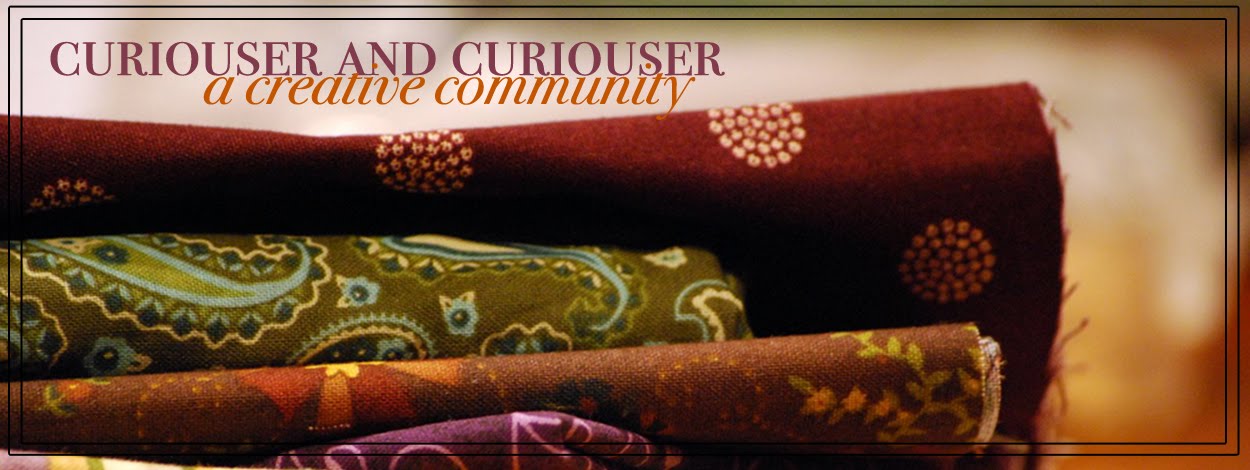I FIANLLY finished my Aviary Quilt and I must say that I am very pleased with it. It is not perfect. The corners do not all match up properly. Its a little bumpy in a few places. And the notes from my quilter after she finished were not words of encouragement telling me how amazed she was at my finery and skill with a sewing machine, or how perfectly each individual block was placed - that there was not a finer layout; each piece was placed in precisely the very spot that would put it in harmony with all the other tones and colors it would be conjoined with (a matter I put a LOT of time into). But it is mine. It is my little creation, and I wanted to share it with all of you. Including a few of the methods, which were all obtained through various blogs, books, and better sewers than myself.
Here we go -
First of all, I must make a special note of the inspiration for this quilt. This beautiful, sweet fabric I found with Jen that one day we went to that glorious candy-store-of-a quilt shop. I loved the little eggs with the little speckles and their names. I bought a yard, having no idea what I was going to do with it. (ever done that before?? Yeah - I do it all the time, too.)

I started with 2 bundles of layer cakes (each piece was about 10" x 10"). And I used just about all of them. I separated them into stacks of lights and darks, first. This is important so that there are rather distinct rows or darks and lights in the finished product. Then, I made pairs of squares from each stack in attractive groupings. I took the two squares, placed one on top of the other and I cut them twice, from one corner to its opposite diamond corner. I had 8 triangles cut from the 2 layer cake squares. I paired two triangles of one pattern with two from the other, sewed them together, and ended up with 2 full squares again.

After I made all of the squares, I placed each piece in the meticulous manner mentioned above. Then I took note of all of the egg patterned material pieces I would need to fill in the border and cut and placed them with the rest. I began sewing, one diagonal strip at a time, then connecting them to each other as I went along. In the picture you can see the rows I had already sewn in strips then attached together in the bottom left corner. In the middle is the diagonal row I just finished which I am about to attach to the rest. And then the top right corner are all the individual squares ready to be connected to one another.
That's the basic body of the quilt. I then did a couple of borders to make it the size I wanted, and to get the look I wanted as well. I did a small border made from the strips of a jelly roll. And I did a much wider border with the pink toile I love so much. There will be a pillow made from the fabric . . . someday.

To show you how I did the binding I have a few self-explanatory photos. First, I stumbled upon this nifty little tool that I have since fallen in love with. Seriously, I am trying to think up projects to do, just so I can use this little thingy. I think it is called, oddly enough, a binding maker. Not sure, but that's what I call it. This is a 1/2" binding maker, which means you need 2" strips of the fabric. You put it through one end and when it comes out the other, it is all folder in this perfect little bi-fold piece of heaven. And you just iron it as it comes through. Makes life much easier. Although, as I gather from my readings, this is not the most sturdy of binding methods, so keep that in mind if you are making something that will get a lot of washing and you want it to last a long time.

My mother-in-law introduced me to these quilter's clips. They were very helpful in having a strong hold on the pieces while they waited to be sewn together. But, I did find that I rather liked the
glass head pins much better when it came to actually sewing. Just my preference from my meager experience as a novice quilter. I am sure I must not have been using them exactly right because, as I sewed, the binding would get pushed and bunched up and I'd have to re-clip over and over again. Maybe it was a tension problem?? Not sure. But the pins elevated the problem, so I went with them instead.

After the binding was complete, I put it right-sides facing each other, against the front of the quilt. Make sure to place it about 1/4" - 1/2" from the raw edge. I sewed along the top edge of the binding, the edge closest to the raw edge of the quilt, as close as possible to the edge of the binding. Then, you just flip it over to the back and hand sew it together with a bind stitch.

















